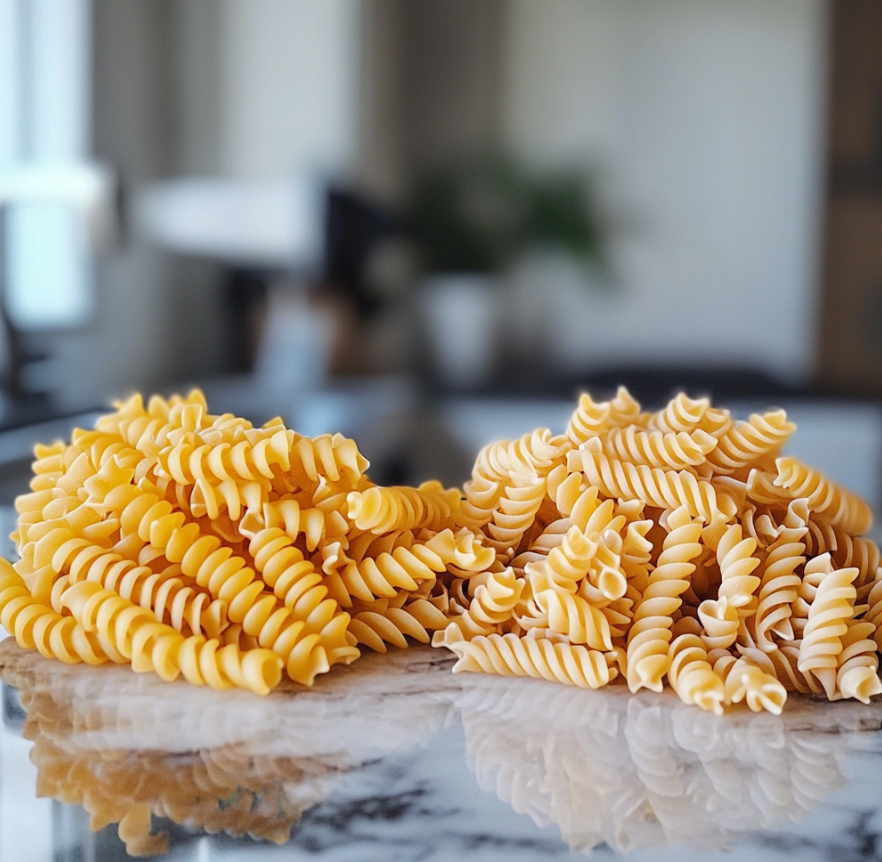Introduction
Pasta salad is a deliciously versatile dish that’s perfect for everything from summer barbecues to quick weeknight dinners. However, creating the perfect pasta salad can be tricky if you’re not aware of some common pitfalls. If your pasta salad has ever turned out too mushy, bland, or just not quite right, you might be making one of these five common mistakes. In this guide, we’ll explore these mistakes and how to avoid them, ensuring your pasta salad is always a hit.
Mistake 1: Choosing the Wrong Pasta Shape
One of the most common mistakes when making pasta salad is selecting the wrong pasta shape. The shape of the pasta you choose is crucial because it affects how well the dressing clings to the pasta and how the overall texture feels. Using long, thin noodles like spaghetti or fettuccine can lead to a pasta salad that’s difficult to eat and doesn’t hold the dressing well.
Instead, opt for short, sturdy shapes like rotini, penne, or bowties. These types of pasta have ridges and curves that help capture the dressing and distribute it evenly throughout the salad. This small change can significantly improve the overall experience of your pasta salad. For more insights on how to select the right pasta, check out this guide on how to cook pasta perfectly.
If you’re looking for more pasta inspiration, you might want to explore other recipes like the Pasta alla Norma recipe for a different take on pasta dishes.

Mistake 2: Overcooking the Pasta
Another common mistake is overcooking the pasta. Mushy pasta not only feels unpleasant in your mouth, but it also absorbs too much dressing, making your salad heavy and soggy. The key to a great pasta salad is cooking the pasta until it’s al dente—firm to the bite yet fully cooked.
To achieve the perfect al dente texture, follow the cooking instructions on the pasta package carefully, but start testing the pasta a minute or two before the suggested time. Al dente pasta holds up better when mixed with other ingredients and dressing, maintaining a good texture even after chilling.
Salting your pasta water properly is also essential. Properly seasoned pasta has a richer flavor and enhances the overall taste of your dish. To learn more about the importance of seasoning pasta water, see why you should always salt your pasta water.
Mistake 3: Not Seasoning the Pasta Water Properly
Speaking of seasoning, another mistake that can ruin your pasta salad is not adding enough salt to the pasta water. This step is crucial because it’s your first and best opportunity to season the pasta itself. If your pasta tastes bland on its own, even the most flavorful dressing won’t be able to fix it.
A good rule of thumb is to add about one tablespoon of salt per gallon of water. This might seem like a lot, but remember that most of the salt stays in the water, and only a small amount is absorbed by the pasta. Properly seasoned pasta ensures that every bite of your salad is flavorful, not just the bites coated in dressing.
Don’t skip this step—it makes a significant difference in the final taste of your pasta salad.

Mistake 4: Incorrect Cooling of Pasta
After cooking your pasta, the way you cool it can also affect the final outcome of your salad. Many people rinse their pasta under cold water to cool it quickly. While this does stop the cooking process, it also washes away the starches that help the dressing cling to the pasta.
Instead of rinsing, spread the pasta out on a baking sheet to cool naturally. This method allows the pasta to cool evenly while retaining the starches that make your pasta salad creamy and cohesive. If you’re in a hurry, you can lightly toss the pasta with a small amount of olive oil to prevent it from sticking together while it cools.
Proper cooling is essential for maintaining the right texture and ensuring the dressing adheres well to the pasta.
Mistake 5: Using the Wrong Dressing
The dressing is arguably the most important component of a pasta salad, and using the wrong one can ruin an otherwise perfect dish. One common mistake is using a dressing that’s too heavy, like one made primarily of mayonnaise, which can make the salad feel greasy and overwhelming. On the flip side, a dressing that’s too light, such as a simple vinaigrette, might not coat the pasta well, leaving it dry and unappetizing.
To avoid this mistake, opt for a balanced dressing that combines creaminess with a bit of acidity, such as a mix of mayonnaise, yogurt, and a splash of vinegar or lemon juice. This type of dressing will coat the pasta evenly without being overly rich. Explore different types of salad dressings to find the perfect match for your pasta salad.
If you’re experimenting with different flavors, you might enjoy trying out a fresh twist on classic dressings, similar to those used in the Avocado Salsa recipe.
Bonus Mistake: Skipping the Add-Ins
While pasta and dressing are the base of your salad, the add-ins are what truly make it special. Skipping add-ins like fresh vegetables, proteins, and herbs can leave your salad feeling one-dimensional. Common add-ins include cherry tomatoes, cucumbers, olives, grilled chicken, or cheese, which not only add flavor but also provide visual appeal and nutritional value.
However, be mindful not to overcrowd your salad. Choose a few complementary ingredients that enhance the flavors of the dish without overwhelming it. This will keep your pasta salad balanced and enjoyable.
FAQs
What pasta is best for pasta salad?
The best pasta shapes for pasta salad are those that can hold onto the dressing, like rotini, penne, or bowties. These shapes help distribute the dressing evenly throughout the salad.
How do you keep pasta salad from getting soggy?
To prevent pasta salad from getting soggy, make sure to cook the pasta al dente and cool it properly without rinsing. Also, be cautious with the amount of dressing you use.
Can you make pasta salad the day before?
Yes, pasta salad can be made the day before. However, it’s best to store the dressing separately and mix it in just before serving to keep the salad fresh and prevent sogginess.
What’s the best way to store pasta salad?
Store pasta salad in an airtight container in the refrigerator. If possible, keep the dressing separate until you’re ready to serve to maintain the salad’s texture.
Can pasta salad be frozen?
Pasta salad is generally not recommended for freezing as it can alter the texture of the pasta and the vegetables, making them mushy once thawed.

